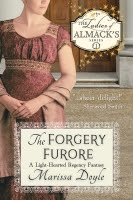 No, I’m not crying…this is just an obscure way to tell you what last week’s Mystery Object was. But before we get into that, let me announce the winner from among the nine correct guesses… Congratulations to Tricia Tighe!
No, I’m not crying…this is just an obscure way to tell you what last week’s Mystery Object was. But before we get into that, let me announce the winner from among the nine correct guesses… Congratulations to Tricia Tighe!Tricia, please contact me through the e-mail form on my website (http://www.marissadoyle.com/contact.php) so we can arrange for you to receive your prize.
So, what was it?
Those of you who said, “a vinaigrette” were spot on, but I accepted “a container for smelling salts” as being close enough, since the function was the same. However, smelling salts were usually contained in a small bottle, rather than in a vinaigrette box. A snuff box lacks the grille and is generally larger (it had to be, to allow the user to reach their thumb and forefinger in to get a pinch). Patch boxes also lacked the grille and were larger, since they usually sat on one’s dressing table. Pills did exist—I have an advertising supplement from the February 1808 edition of the magazine La Belle Assemblee which lists “Hope’s Hectic Pills” (love the name!) which were purported to cure consumption, and “The Rev. Mr. Barclay’s Patent Anti-Bilious Pills”, as recommended by The Right Hon. Viscount Dillon and The Lord Bishop of Bath and Wells—but a pill box would also not have a grille. Card cases and jewelry boxes would be much larger—remember, this measures a little longer than an inch. And ladies did not carry make-up with them much before the last decades of the century—few would admit to using it, as only actresses and ladies of dubious virtue used “paint”.
So what was a vinaigrette, and what was it for?
A vinaigrette was a box that held a small piece of sponge, soaked in vinegar in which various strong aromatics (herbs or other substances) had been dissolved. It’s not unheard of to run across vinaigrettes today that still have their original piece of sponge intact. A common component in both vinaigrettes and in smelling salts was hartshorn, which was what it sounds like—a distillate made from the rendered horns of certain deer, which was high in ammonia. If you’ve ever opened a bottle of ammonia and caught a whiff, you’ll know just how aromatic it is!
 Vinaigrettes were used mainly to ward off faintness or headache, and if necessary could also be used to sniff to ward off bad smells (though I’m not sure if sniffing ammonia is all that much preferable!). If you read Georgette Heyer or other Regency period stories, you’ll usually bump into one being used by an overly dramatic dowager or two. But it does seem like 19th century ladies had a propensity to fainting. I have to wonder if some ladies affected it, as it made them look like creatures of heightened sensibility, fluttery, ethereal beings easily moved to excesses of emotion by anything shocking or sad or exciting or even just pretty…a tendency which, believe it or not, was admired in females. The wonderful picture above shows a lady supposedly overcome by the excitement of just having waltzed with this dashing fellow (I'm not kidding!) In later times I wonder too if tight corset lacing wasn’t responsible for making women more susceptible to fainting.
Vinaigrettes were used mainly to ward off faintness or headache, and if necessary could also be used to sniff to ward off bad smells (though I’m not sure if sniffing ammonia is all that much preferable!). If you read Georgette Heyer or other Regency period stories, you’ll usually bump into one being used by an overly dramatic dowager or two. But it does seem like 19th century ladies had a propensity to fainting. I have to wonder if some ladies affected it, as it made them look like creatures of heightened sensibility, fluttery, ethereal beings easily moved to excesses of emotion by anything shocking or sad or exciting or even just pretty…a tendency which, believe it or not, was admired in females. The wonderful picture above shows a lady supposedly overcome by the excitement of just having waltzed with this dashing fellow (I'm not kidding!) In later times I wonder too if tight corset lacing wasn’t responsible for making women more susceptible to fainting.I hope you had fun with this!





2 comments:
Interesting!
I would think that they would be especially useful later in the nineteenth century because of the corsets being too tight on top of all the layers of fabric one had to wear. Imagine what it would have been like in the sweltering summer months at a ball dressed in ten pounds of clothing!
Thanks for the information! It was fun guessing.
I think ladies were expecting to be frail creatures and that some shrewd young misses probably used that image to their advantage and perfected the artful swoon. What better way to get a dashing young man's attention and steal his affections away from a rival?
Post a Comment